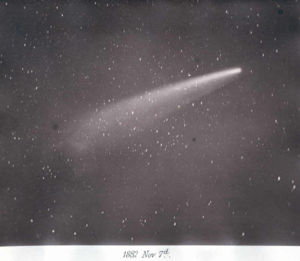Great Comet of 1882
2007 Schools Wikipedia Selection. Related subjects: Space (Astronomy)

The Great Comet of 1882 formally designated C/1882 R1, 1882 II, and 1882b, was a comet which became very bright in September 1882. It was a member of the Kreutz Sungrazers, a family of comets which pass very close to the Sun's surface at perihelion. The comet was bright enough to be visible next to the sun in the daytime sky at its perihelion.
Discovery
The comet appeared suddenly in the morning skies of September 1882, and as it was already visible to the naked eye when it became visible it was discovered independently by many people. Reports suggest that it was first seen as early as 1 September 1882, from the Cape of Good Hope as well as the Gulf of Guinea, and over the next few days many observers in the southern hemisphere reported the new comet.
The first astronomer to see the comet was W. H. Finlay, the Chief Assistant at the Royal Observatory in Cape Town, South Africa. Finlay's observation on September 7 was also an independent discovery, and he reported that the comet had an apparent magnitude of about 3, and a tail about a degree in length.
The comet brightened rapidly, and within days had become an exceptionally bright object. Her Majesty's Astronomer at the Cape, David Gill, reported watching the comet rise a few minutes before the Sun on 18 September, and described it as "an ill-defined mass of golden glory...with a beauty I cannot describe".
Perihelion
The comet was rapidly approaching perihelion when discovered, and orbital studies determined that it was a Sungrazing comet, which would pass extremely close to the surface of the Sun. For many hours either side of its perihelion passage, the comet was easily visible in the daytime sky next to the Sun. It reached an estimated magnitude of −17.
Perihelion was reached on September 17, and shortly afterwards the comet transited the Sun. At the Cape, Finlay observed the comet with the aid of a neutral density filter right up until the moment of transit, when the Sun's limb was "boiling all about it". Finlay noted that the comet disappeared from view very suddenly, and no trace of it could be seen against the Sun's surface.
Post-perihelion evolution
After its perihelion passage, the comet moved into dark skies, and although it faded as it receded from the Sun it remained one of the most prominent objects in the sky. Towards the end of September, observers including E. E. Barnard began to notice that the comet's nucleus was elongated, and by the beginning of October it was clear that it had broken into at least six fragments. Observers reported that the relative brightness of the fragments varied from day to day.
In mid-October, the comet developed a notable anti-tail, pointing towards the Sun. Anti-tails are a fairly common cometary phenomenon, and result from orbital geometry giving the appearance of a tail pointing towards the Sun although material can only be driven away from the Sun.
The comet faded gradually, but despite its fragmentation it remained visible to the naked eye until February of 1883. The last definite sighting of the comet was made on June 1, 1883.
Orbital studies
Studies of the orbit of the comet showed that the Great Comet of 1882 was moving on an almost identical path to previous great comets seen in 1843 and 1880. These comets had also suddenly appeared in the morning sky and had passed extremely close to the Sun at perihelion. One suggestion was that all three were in fact the same comet, with an orbital period that was being drastically shortened at each perihelion passage. However, studies showed this to be untenable, as the orbital period of each was 600-800 years.
Heinrich Kreutz studied the orbits of the three great comets, and developed the idea that the three comets were fragments of a much larger progenitor comet which had broken up at an earlier perihelion passage. The fragmentation of the Great Comet of 1882 itself demonstrated that this was plausible. It is now thought that the Great Comet of 1882 is a fragment of X/1106 C1, and that Comet du Toit (C/1945 X1) and Comet Ikeya-Seki (C/1965 S1) are two of its sister fragments.
It is now well established that the comets of 1843, 1880, 1882 and many others are all members of a family known as the Kreutz Sungrazers, which are all descended from one comet, probably that seen by Aristotle in 371 BC. The fragments of the Great Comet of 1882 will return in several hundred years time, spread out over perhaps two or three centuries.